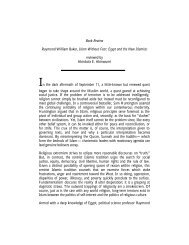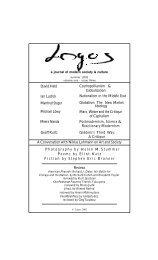Michael J. Thompson Stephen Eric Bronner Wadood Hamad - Logos
Michael J. Thompson Stephen Eric Bronner Wadood Hamad - Logos
Michael J. Thompson Stephen Eric Bronner Wadood Hamad - Logos
Create successful ePaper yourself
Turn your PDF publications into a flip-book with our unique Google optimized e-Paper software.
Ali Hossaini<br />
other words, perspectival drawing lies between the delicate naturalism of<br />
Paleolithic painting and the stark realism of photography. During the<br />
Renaissance, the production of art began to be mechanized, and picture<br />
making went beyond expression to become media.<br />
The work of Lewis Mumford may clarify my position. In Technics and<br />
Human Civilization, Mumford introduces the concept of the megamachine, a<br />
social machine that coordinates human rather than nonhuman energy.<br />
Arising in early civilizations, the megamachine arose when leaders used<br />
scientific principles to increase the size, power and precision of work crews.<br />
By coordinating human labor with precise measurements and tools, early<br />
leaders were able to direct the construction of massive pyramids without the<br />
use of engines and other advanced technologies. Unlike many other human<br />
endeavors, a primary feature of the megamachine is the dominance of<br />
method. Like an inorganic mechanism, workers applied tools of<br />
measurement that let them precisely engineer buildings according to plan.<br />
Their own judgment was auxiliary to measurements and central direction.<br />
Like earlier surveyors and architects, Renaissance painters allowed scientific<br />
principles to determine the structure of their work. Their work was closely<br />
allied with engineering and architecture. Optical effects were difficult to<br />
realize with medieval tools, so artists quickly adopted more advanced<br />
machines to assist their efforts. The requirements of perspective conditioned<br />
the emergence of the camera obscura in the late Renaissance, and the desire<br />
of successive generations to fully automate image production led to<br />
photography. The process continues today. Electronic processing is<br />
dematerializing the camera into the universal machine (and universal<br />
medium) of computers. New technologies like digital animation and virtual<br />
reality use optical principles, but, like Renaissance painting, they posit the<br />
camera as an ideal machine, a perspective that organizes representation<br />
according to a coherent point of view.<br />
Photographs function by reproducing the vantage of the eye, and the analogy<br />
between eyes and cameras runs deep. As Kuhne first demonstrated, the eye is<br />
a camera, and vice versa, and they can sometimes be exchanged. Our<br />
understanding of the brain is on the increase; it seems likely that, in the near<br />
future, cameras will induce vision through direct neural implants. 4 When fed<br />
directly to the brain, media becomes immediate, more like an environment<br />
than an overlay. McLuhan’s description of an optical-electronic nervous<br />
system may have sounded fictional when he uttered it, but it is rapidly<br />
<strong>Logos</strong> 2.3 – Summer 2003




